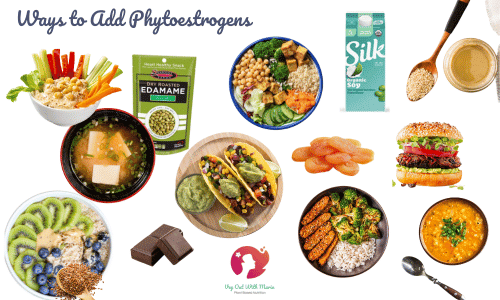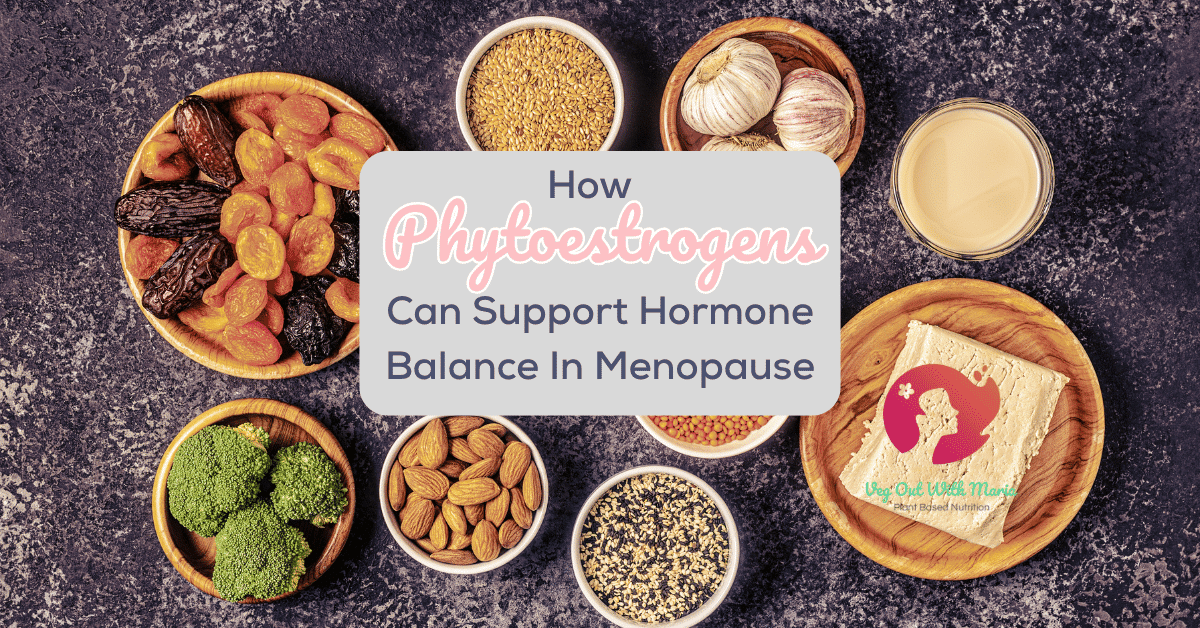As your estrogen levels take a nose dive, your risk for bone and heart issues increases, as well as symptoms such as hot flashes, night sweats, mood swings, and sleep disturbances.
Hormone replacement therapy (HRT) can be a game-changer for alleviating many of these symptoms. While HRT is an option for many women, there are also food-based strategies that can provide additional support.
Certain foods containing phytoestrogens have estrogen-like activity. These natural plant compounds may help smooth the effects of shifting hormones and offer a supportive role in managing menopause symptoms.
What Are Phytoestrogens?
Phytoestrogens are naturally occurring compounds found in plants that can weakly mimic the effects of estrogen in the body. They do this by binding to certain estrogen receptors, though their action is far less potent than the body’s own estrogen or prescribed HRT.
There are two main types of estrogen receptors in the body, alpha and beta receptors. These receptors are located in different tissues in the body. While natural estrogen binds to both alpha and beta receptors, phytoestrogens tend to have an affinity for beta receptors.
Instead of overwhelming the system, phytoestrogens can act as gentle modulators. When estrogen levels are low, as they are in menopause, phytoestrogens can provide a mild boost. On the flip side, when estrogen is relatively high, they may block stronger estrogen from binding, creating a balancing effect.
This makes them unique compared to synthetic hormones: while HRT directly replaces declining estrogen, phytoestrogens support the body’s natural rhythm in a subtler way.
Types of Phytoestrogens
Not all phytoestrogens are the same. There are four main groups found in food:
- Isoflavones: Found primarily in soy products (tofu, tempeh, soybeans, soy milk) as well as chickpeas and lentils.
- Lignans: Richest in flaxseeds and sesame seeds, but also present in whole grains, legumes, and some fruits and vegetables.
- Coumestans: Less common, found in split peas, pinto beans, red clover, and alfalfa sprouts.
- Stilbenes (like resveratrol found in grapes, wine, peanuts)
Other flavonoids, including quercetin and anthocyanins, are also considered phytoestrogens.
The impact of these phytoestrogens depends on factors like your gut microbiome, overall diet, and hormone status. This may explain why some women notice significant benefits while others experience more subtle changes.
Benefits of Phytoestrogens in Menopause
Some potential benefits of including foods rich in phytoestrogens include:
1. Hot Flashes & Night Sweats
Several studies suggest that women who consume phytoestrogen-rich foods, especially soy isoflavones, may experience fewer and less severe hot flashes.1
A 2021 randomized controlled trial – the WAVS study (Women’s Study for the Alleviation of Vasomotor Symptoms) – looked at the effects of a low-fat plant-based diet plus the addition of 1/2 cup of cooked soybeans daily on postmenopausal women. Moderate to severe hot flashes were reduced by 84% along with improved quality of life.2
2. Bone Health
Estrogen plays a crucial role in maintaining bone density. As levels drop during menopause, the risk of osteoporosis rises. Phytoestrogens, particularly from soy and flax, may help slow bone loss, enhance bone density, and support long-term skeletal health. 3, 4, 5
Of course, many things impact bone health: magnesium, calcium, vitamin D, vitamin K, protein, and weight-bearing exercise. Eating a nutrient-dense diet including phytoestrogen-rich foods can have a positive impact on your bones.
3. Heart Health
Phytoestrogens can positively influence cholesterol levels by lowering LDL (“bad” cholesterol) and increasing HDL cholesterol, supporting vascular function, and improving blood pressure. 6, 7, 8 Since heart disease risk increases after menopause, these effects can be especially valuable.
4. Mood & Cognitive Support
Although research is still evolving, phytoestrogens may help with mood swings and cognitive function. Their gentle influence on estrogen receptors in the brain may support memory, concentration, and emotional balance. 9, 10
5. Inflammation & Immune System
Phytoestrogens may have beneficial effects on inflammation and immune function, particularly during menopause when estrogen levels naturally decline. Estrogen itself has anti-inflammatory properties, so its reduction can contribute to higher levels of systemic inflammation, which may play a role in joint pain, fatigue, and increased risk for chronic disease.
Phytoestrogens, especially those found in soy and flaxseeds, can help modulate inflammatory pathways by interacting with estrogen receptors and influencing the production of inflammatory markers like C-reactive protein (CRP) and cytokines. 11, 12
In addition to their hormone-like activity, phytoestrogens also act as antioxidants, reducing oxidative stress that can trigger inflammation. They may support a more balanced immune response, helping the body manage inflammation without suppressing immune defenses.
Food Sources of Phytoestrogens
The best way to increase phytoestrogen intake is through whole, plant-based foods!
Some top sources include:
- Soy products: tofu, tempeh, edamame, soy milk, miso.
- Flaxseeds: freshly ground for maximum benefit.
- Sesame seeds: sprinkle on salads, stir-fries, or baked goods.
- Legumes: chickpeas, lentils, black beans, pinto beans.
- Whole grains: oats, rye, barley, brown rice.
- Garlic and onions: part of the allium family, rich in flavonoids.
- Fruits and cruciferous vegetables: dried apricots, dates, prunes, peaches, grapes, berries, broccoli, cabbage, kale, Brussels sprouts.
- Dark chocolate: yes, please!
Easy Tips to Add Them Daily:
- Snack smart. Try roasted edamame, soy nuts, hummus with veggies, or trail mix with sesame seeds and dried apricots or dates for a phytoestrogen-rich snack.
- Add tofu or tempeh to meals. Try tofu in stir-fries, Buddha bowls, soups, or scrambles, and use tempeh in sandwiches, salads, or grain bowls for a hearty, plant-based protein.
- Add 1-2 tablespoons of ground flaxseeds to smoothies, yogurt, oatmeal, and baked goods.
- Bean and lentil up! Start incorporating more beans and lentils into your diet by making lentil curry or soup, adding chickpeas to salads, or trying black bean burgers or tacos.
- Sprinkle sesame seeds on roasted veggies or tofu dishes. Try making dips, spreads, or salad dressing using tahini (sesame seed paste).
- Use organic soy milk as the base for your smoothies, overnight oats, or chia pudding.
- Choose whole grains more often. Oats, barley, rye, and brown rice all provide small amounts of lignans that add up over time.
- Balance your plate. Combine phytoestrogen-rich foods with plenty of fruits, vegetables (especially cruciferous vegetables), and healthy fats for optimal nutrient absorption and hormone support.
- Treat yourself with dark chocolate: enjoy 1oz or 30g daily, or add some cacao powder to shakes or smoothies.

Safety and Considerations
Because of their structural similarity and ability to bind to estrogen receptors, there have been concerns that phytoestrogens can interfere with normal hormone signaling. You will often see them labeled as endocrine disruptors.
Specific concerns include:
Cancer risk: Because estrogen can play a role in stimulating cell growth, there were fears that phytoestrogens might cause tumor growth (like breast or endometrial cancer). In fact, it appears that phytoestrogens may actually be protective against cancer. 13
Reproductive effects: Early animal studies suggested that high doses of isoflavones (particularly genistein from soy) could alter reproductive development or fertility. It turns out mice and humans metabolize isoflavones differently, and this has not been demonstrated in humans.14
Thyroid function: Previous animal and test-tube studies suggested that soy isoflavones may reduce thyroid gland function by competing with thyroid hormones for iodine. More recent findings, however, have shown that soy isoflavones have little to no impact on thyroid function15,16.
That being said, it is important to ensure you are taking in adequate iodine: not too little, not too much. If you are plant-based, I recommend taking a daily iodine supplement (150 mcg) to make sure you are hitting the RDA.
Also, if you have hypothyroidism and are on thyroid medication (such as levothyroxine), it would be a good idea to wait 4 hours before or after taking this medication to consume soy, as it can interfere with the way thyroid hormone is absorbed. The same holds true for calcium and iron supplements, antacids, and cholesterol medication, which can all interfere with the absorption of levothyroxine.
Human research overwhelmingly indicates that normal consumption of soyfoods and other phytoestrogen-rich foods does not disrupt endocrine function and may, in fact, offer protective benefits for bone, heart, and hormone health as mentioned above. 17, 18
Lifestyle Synergy
Phytoestrogens can be powerful allies, but they work best when paired with other healthy habits:
- Balanced, plant-forward diet with fiber, healthy fats, and lean or plant-based protein.
- Regular movement, especially strength training, to protect bone and muscle.
- Stress management through mindfulness, breathing practices, yoga, or meditation.
- Good sleep hygiene to support hormone regulation.
- Limiting alcohol and processed foods that can worsen menopause symptoms.
Together, these strategies create a strong foundation for thriving through menopause.
Conclusion
Phytoestrogens offer a gentle, food-based way to support hormone balance, potentially reducing menopausal symptoms and protecting long-term health.
These plant compounds are most effective as part of a varied, nutrient-rich diet, not as a single “magic fix.” Interestingly, the impact of phytoestrogens depends on factors like your gut microbiome, overall diet, and hormone status.
By incorporating more soy foods (look for organic), flax and sesame seeds, legumes, and whole grains into your daily meals, you can tap into the power of plants to smooth the journey. While they aren’t a replacement for hormone therapy, phytoestrogens are a safe, nourishing complement that can help women feel more in control of their health.


